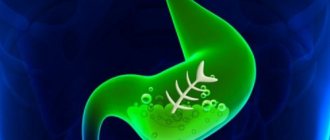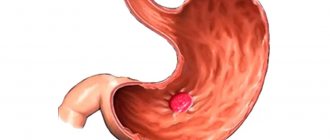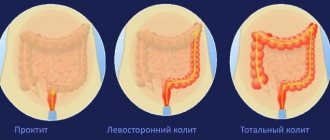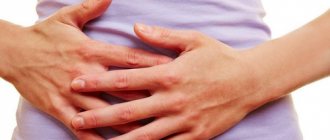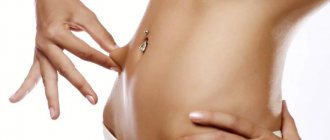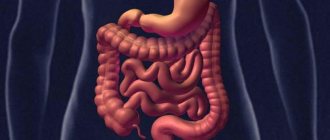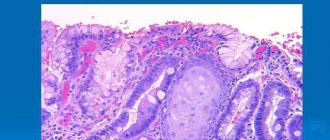Psychotherapist
Krashkina
Irina Ivanovna
30 years of experience
Psychotherapist, Candidate of Medical Sciences, member of the Russian Professional Psychotherapeutic League
Make an appointment
Therapists are most often approached with complaints that are characteristic of disorders of the digestive system. Everyone should know what the symptoms of dyspepsia are in an adult. Diagnosis requires a serious differential approach, since this group includes all nonspecific signs of symptom complexes of the gastrointestinal tract. Treatment of dyspepsia directly depends on the causes of the disease, and in most cases this is a deficiency of digestive enzymes or poor nutrition.
Symptoms and signs of dyspepsia
Dyspepsia syndrome is a digestive disorder and symptoms that are characteristic of various diseases of the gastrointestinal tract and their borderline phases.
When digestion is disturbed, symptoms appear that are united by a common name - gastric dyspepsia, this includes:
- problems with swallowing;
- nausea and vomiting attacks;
- belching;
- pain in the stomach;
- heartburn;
- rumbling in the stomach;
- bloating;
- constipation, diarrhea.
Dyspepsia of the stomach and intestines causes pain in the epigastric region. They can be either quite intense or in the form of mild discomfort. There is a feeling of rapid satiety and fullness, and as a result, nausea, belching, and heartburn. Another alarming sign is loss of appetite, quickly and sharply. After this, the person begins to lose weight for no reason. Intestinal dyspepsia is accompanied by rumbling in the stomach, flatulence, diarrhea or constipation.
Disruption of the process of digesting food in the intestines may indicate pathologies such as dysbiosis, diverticulitis, enzymopathy, enteritis, colitis, tumors in the intestines, irritable bowel syndrome, pancreatic diseases, and metabolic pathologies. Also, intestinal dyspepsia may indicate that an infection is developing in it (dysentery, cholera, intestinal tuberculosis, salmonellosis, etc.).
There are 2 main groups of dyspeptic disorders - functional dyspepsia and organic. In the first case, only disturbances in the functioning of the organ are detected, that is, functional lesions, while in the second they are exclusively organic in nature. In the latter case, the symptoms will be more pronounced, and the disorders will continue for a long time.
Causes of dyspepsia
Most often, dyspepsia is caused by a lack of digestive enzymes, as well as poor nutrition.
The development of this pathological condition of the body can also be caused by:
- frequent stress;
- neurological diseases;
- binge eating;
- improper eating.
In addition, dyspepsia may develop after the following organic diseases:
- gastritis;
- diseases of endocrine organs;
- stomach or duodenal ulcer;
- uncontrolled use of medications;
- stomach tumors;
- pancreatic pathology;
- gallbladder diseases.
In children, the cause of the disease is usually a discrepancy between the composition and quantity of food consumed and the capabilities of their digestive system. In other words, careless introduction of new foods into the baby’s diet and overfeeding lead to the development of the disease.
The development of dyspepsia syndrome in young children is facilitated by the immaturity of the digestive tract. In older children, dyspepsia most often occurs against the background of hormonal imbalance during puberty.
Causes
There are several forms depending on the reasons that cause the development of the syndrome:
- simple dyspepsia. It is also called nutritional. Caused by nutritional problems. In turn, there is fatty (soapy), fermentative and putrefactive dyspepsia. In the latter case, it develops if the food is dominated by protein products or stale meat is used. Fermentation develops from excessive consumption of carbohydrates (bread, cabbage, legumes, sugar) and drinks that cause fermentation (beer and kvass). Fatty dyspepsia develops with excessive consumption of fatty foods, especially pork and lamb;
- dyspepsia associated with a deficiency of secreted enzymes for digesting food in the intestines and stomach. In turn, it can be gastrogenic (lack of enzymes in the stomach), pancreatogenic (deficiency of pancreatic substances), enterogenic (lack of intestinal juices), hepatogenic (insufficient secretion of bile from the liver);
- dyspepsia, which is associated with problems with the absorption of food in the intestines with malabsorption syndrome. As a result, nutritional components do not flow from the intestines into the blood;
- dyspepsia, which is associated with intestinal infections. In this case, it could be either dysentery or salmonellosis.
- intoxication. It manifests itself due to poisoning in various diseases, including influenza, acute surgical pathologies, and also when consuming poisons.
All of these factors can contribute to the onset of the disease. Symptoms and treatment of dyspepsia of the stomach and intestines directly depend on the causes.
Diagnostic criteria
These include:
1. The patient has one or more symptoms:
- Epigastric pain.
- Fast saturation.
- Feeling of fullness after eating.
- Burning sensation.
2. Lack of any data (including the results of FGDS) confirming organic pathology.
3. Symptoms must bother the patient for at least 6 months, and during the last 3 months there must be compliance with the above criteria (presence of a clinic and absence of organic pathology).
Two forms of the disease have been identified, based on the mechanisms of dyspepsia:
- Epigastric pain syndrome.
- Postprandial distress syndrome (disturbances are based on symptoms arising in connection with food intake).
Etiology
The specific causes of this disease have not been fully elucidated. It is assumed that the following factors can provoke its occurrence:
- Hereditary predisposition.
Some genetically determined enzymes that can predispose to the development of this type of disorder.
- Psychotraumatic and stressful situations.
Acute stress or long-term, chronic exposure can trigger symptoms. Personality and character traits, hypochondria and increased susceptibility to criticism, suspiciousness are common character traits that are found among patients.
- Smoking.
The risk of developing pathology among smoking patients increases by 2 times compared to non-smokers.
- Alcohol abuse.
Regular consumption of alcohol causes impaired motility and affects the protective properties and structure of the gastric mucosa.
- Drinking coffee and strong tea in large quantities.
- Addiction to hot sauces and seasonings.
- Hypersecretion of HCl.
- Helicobacter pylori infection.
Approximately 50% of patients with an established diagnosis are infected with H. pylori, and a triple infection eradication regimen often does not bring clinical effect.
Pathogenesis
Among the leading mechanisms for the development of pathology are the following factors:
- Dysfunction of the gastrointestinal endocrine system.
- Imbalance of the sympathetic and parasympathetic parts of the autonomic nervous system, coordinating the gastroduodenal zone.
- Impaired ability of the stomach walls to relax under the influence of increasing pressure of the contents during food intake, impaired motor function and peristalsis.
- Increased sensitivity of stomach receptors to stretching (observed in 60% of patients).
These pathogenic mechanisms, together with provoking factors, in many cases cause the disease.
It should be noted that neurotic disorders are one of the frequent “trigger” moments in the formation of dyspepsia: sleep disturbance, feelings of anxiety, depression, headaches can contribute to failure and incoordination in the gastrointestinal tract.
Risk factors
These include:
- frequent and severe stress, emotional tension. In this case, the pathology will have a neurotic origin;
- some medication use. This applies to antibiotics, hormonal or antitumor and other agents;
- poor nutrition. Most often this concerns overeating;
- intoxication. In this case, there may be either a disease of viral or bacterial origin, or household poisoning;
- excessive release of hydrochloric acid;
- problems with gastrointestinal motility.
These are the main factors that contribute to the occurrence of dyspepsia.
Causes
There are several theories to explain this condition. The first is associated with increased permeability of the gastrointestinal mucosa. Microcracks become entry points for bacteria and their toxins. The latter irritate the nerve endings and cause unpleasant symptoms of dyspepsia.
The cause is also a violation of motility (muscle function) of the gastrointestinal tract. This leads to a delay in gastric emptying, discomfort and heaviness in the epigastrium.
Another assumption: people with dyspepsia have excessive sensitivity of the mucous membrane of the esophagus and stomach to common irritants. Even with normal acid formation, heartburn or sour belching occurs.
Chronic stress (at work, in the family) and personality traits also contribute to functional impairment. More often, dyspepsia is observed in people who have suffered severe psychological shock or are afraid of a serious illness. Excessive demands on oneself or on the part of others similarly contribute to dyspepsia.
There is also an opinion that irritable stomach syndrome is provoked by taking non-steroidal anti-inflammatory drugs (NSAIDs). Viral infections, such as rotavirus, play a role.
Complications
Gastric dyspepsia occurs in diseases such as esophagitis, GERD, cancer, stenosis or ulcer of the esophagus, cancer or the presence of benign tumors, periesophagitis, scleroderma, diverticulum. Also, the presence of dyspepsia of the stomach and intestines may indicate diseases of the muscles, central and peripheral nervous systems, pathologies of internal organs, for example, narrowing of the esophagus can be caused by cysts and tumors that oppress it from the outside. This also applies to aortic aneurysm, vascular anomalies, and thyroid hyperplasia.
Complications of dyspepsia are most often associated with the underlying illness that causes the appearance of this syndrome. The patient may suddenly lose weight and lose appetite for a long time. One of the severe consequences is Mallory-Weiss syndrome. In this case, the mucous layers of the lower part of the esophagus, where it passes into the stomach, rupture. Because of this, gastric bleeding begins. It can be quite intense and even lead to death. Most often, the occurrence of Mallory-Weiss syndrome is associated with repeated bouts of vomiting.
When to see a doctor
For treatment of stomach or intestinal dyspepsia, you should contact a gastroenterologist. Don't delay going to the doctor. Particular attention should be paid to such symptoms as abdominal pain at night, sudden weight loss for no reason, nausea, vomiting, frequent belching, and heartburn attacks. Diagnostics can be carried out at JSC "Medicine" (clinic of Academician Roitberg), which is located in the center of Moscow.
Symptoms of dyspepsia
The clinical picture largely depends on the type of dyspepsia, but there are a number of common signs that are observed in almost all cases of the disease.
Common symptoms of dyspepsia include:
Discomfort in the epigastric area. The patient feels a nagging, mild pain and a feeling of fullness. In addition, he has symptoms of dyspepsia such as belching, nausea, flatulence, and upset stool.
A combination of dyspeptic symptoms with signs of GERD (pain behind the sternum when swallowing, heartburn, loss of appetite) is possible.
In the putrefactive form of the disease, the patient feels severe weakness, a false urge to defecate, and begins to vomit. The stool is loose, the stool is dark. Loss of appetite, intestinal colic is observed.
In some cases, the patient experiences headaches and develops insomnia. Undigested food remains can be discerned in the stool.
Fermentative dyspepsia is a consequence of poor digestion of carbohydrates. It is manifested by changes in appetite, stool disturbances, flatulence, nausea, belching, and bloating. The patient passes gas and experiences frequent diarrhea (up to four times a day). The stool is light, foamy, with a sour odor, there is no mucus or blood in it. This type of dyspepsia usually manifests itself in spring and summer. The disease can occur in both acute and chronic forms.
With fatty dyspepsia, which is often a consequence of dysfunction of the pancreas, diarrhea occurs less frequently than with other types of disease. The stool is profuse, the stool is whitish in color, and contains remnants of undigested fat.
Dyspepsia in pregnant women is manifested by pain and bloating, severe heartburn, indigestion, nausea and vomiting, and a feeling of fullness in the stomach that occurs after every meal.
Dyspepsia in young children is manifested by bloating, colic, frequent regurgitation, and frequent bowel movements.
Diagnosis of dyspepsia
Before starting treatment for dyspepsia, it is necessary to undergo an examination, which includes not only a description of complaints, an external examination, but also the following:
- laboratory tests - general and biochemical blood tests, examination of stool for the presence of blood, coprogram;
- instrumental studies - a test for gastric acid secretion, esophagogastroduodenoscopy, examination of gastric materials for the presence of Helicobacter pylori, ultrasound of the abdominal organs, colonoscopy, radiography, computed tomography, esophageal and antroduodenal manometry.
You can undergo diagnostics at JSC "Medicine" (clinic of Academician Roitberg), which is located in the central district of Moscow, near the Tverskaya, Novoslobodskaya, Belorusskaya, Chekhovskaya metro stations. If you have a disease, you may need to consult not only a gastroenterologist, but also other specialists: a psychiatrist, neurologist, cardiologist, endocrinologist.
Diagnosis of dyspepsia
Depending on the clinical picture and type of disease, the following examinations may be prescribed to the patient to diagnose dyspepsia:
- stool analysis - performed to assess food digestion;
- examination of the air exhaled by the patient - this study is carried out to detect the bacterium Helicobacter pylori, which provokes many gastrointestinal diseases;
- Ultrasound;
- FEGDS - endoscopic examination of the esophagus, stomach and duodenum - is one of the main methods for diagnosing the disease;
- radiography;
- blood and urine tests;
- MRI, ;
- analysis for worm eggs and a number of others.
Treatment
To treat dyspepsia, drug therapy is necessary. Separately, you need to get rid of diarrhea or constipation, and for this purpose special means are prescribed. Other drugs are also prescribed to treat dyspepsia and alleviate the patient’s condition:
- painkillers (antispasmodics);
- drugs that reduce the level of acidity in the stomach;
- enzyme agents to improve digestion processes.
Treatment must be comprehensive and systemic. It is necessary to treat the disease that caused dyspepsia, that is, gastritis, duodenitis, GERD, cholecystitis, gastric or intestinal ulcers, pancreatic diseases.
Treatment of functional dyspepsia
It is worth understanding that the treatment of functional dyspepsia must be comprehensive. Therapy with folk remedies, drugs and medicines, including antisecretory and antacid medications, gives good results.
Patients are prescribed drugs such as Metacin, Famocidin, Almagel, Rennie and other drugs, taking into account the specific form of the disease and the presence of other diseases. Effective treatment of dyspepsia is possible only under the supervision of an experienced gastroenterologist.
General clinical recommendations include the introduction into the diet of foods that normalize the functioning of the stomach, including fermented milk products, fresh vegetables, cereals and vegetable oils. Proper nutrition should be fractional; patients need to eat at least 4-5 times a day in small portions.
In case of functional dyspepsia of the stomach of a non-ulcer type, possible stress should be eliminated, walks more often and light physical exercises that normalize the state of the nervous system should be included in the daily routine.
Myths and dangerous misconceptions in the treatment of dyspepsia
Main misconceptions:
- nausea, heaviness and bloating will go away on their own. They are temporary, so you don't have to go to the hospital;
- antispasmodics or enzyme agents remove heaviness in the stomach and discomfort in the intestines;
- If you eat something sour or spicy, the discomfort will disappear.
All of the above opinions are completely wrong. You should not rely on myths that were previously believed. If alarming symptoms appear, you should consult a specialist.
Symptoms of the disease
The characteristic symptoms of functional dyspepsia that the patient complains of may appear from time to time or be chronic.
The acute form occurs:
- in young children who were transferred to artificial feeding;
- as a result of infection entering the body along with spoiled food;
- in the presence of bacterial diseases, for example, otitis media.
Constant functional gastric dyspepsia, the symptoms of which depend on its stage, accompanies patients with gastrointestinal diseases.
In adults, a dyskinetic variant of the pathology is often observed, when they are bothered by a feeling of heaviness and rapid satiety, the stomach often hurts, nausea and bloating of the upper peritoneal cavity are recorded.
The presence of chronic gastritis with high acidity in the stomach always guarantees the development of dyspeptic syndrome. Despite the rather extensive symptoms of the pathology, a number of main signs can be identified that indicate the presence of dyspepsia of one type or another. This list includes:
- feeling of heaviness in the epigastric region;
- increased appetite and sour belching due to excessive accumulation of acid in the stomach;
- prolonged absence of stool;
- aching pain accompanied by heartburn;
- hunger pains, nausea and vomiting, heaviness in the stomach;
- lack of appetite combined with abdominal pain.
Prevention of dyspepsia
The main measures to prevent the disease are:
- proper nutrition;
- treatment of pathological conditions that can lead to the development of dyspepsia;
- avoidance of stress and other psycho-emotional disorders;
- regular sanitation of foci of chronic infection in the body;
- cessation of alcohol abuse and smoking;
- giving up a sedentary lifestyle - daily walks in the fresh air, physical education;
- weight control, preventing the development of obesity;
- refusal of uncontrolled use of medications;
- strengthening immune defense;
- avoiding constant increased stress on the abdominal muscles;
- Regularly undergoing preventive examinations - this will help to identify pathological changes in the body at an early stage, which will allow for effective corrective therapy and prevent the development of complications.
Good health to you!
Treatment methods
Dyspepsia needs treatment. Medicines, folk recipes and other methods (proper nutrition, physical activity, etc.) are used as therapy.
Medications
Medicines help eliminate negative symptoms and alleviate a person’s condition. The table shows commonly prescribed drugs for dyspepsia.
| Group of drugs | Action of funds | List of medications |
| Sedatives | The drugs help normalize a person’s emotional background. The group is prescribed if dyspepsia appears due to stress. | Novo-Passit, Afobazol, Persen |
| Antiemetics | Medicines eliminate vomit. | Domperidone, Metoclopramide, Motilium |
| Antidiarrheal | The drugs eliminate loose stools. | Imodium, Loperamide, Lopedium |
| Dehydration | The products replenish the lack of fluid in case of severe vomiting or diarrhea. | Regidron |
| Analgesics | Medicines relieve pain. | Analgin, Baralgin, Bral |
| Nonsteroidal anti-inflammatory drugs (NSAIDs) | The drugs reduce pain, inflammation, and temperature. | Nurofen, Ibuprofen, Nise |
| Sleep improvers | Medicines help normalize sleep, make it easier to fall asleep, and eliminate night awakenings. | Melaxen, Donormil, Melatonin |
| Antacids | The drugs neutralize the acid produced by the stomach. Antacids help relieve heartburn. | Rennie, Almagel, Gastal |
| Enzymatic | Medicines improve digestion. | Festal, Mezim, Creon |
| Proton pump inhibitors | The drugs reduce the synthesis of hydrochloric acid in the stomach. Thanks to this, heartburn is eliminated. This group is prescribed for gastroesophageal reflux disease. | Omez, Omeprazole, Pariet |
| H2-histamine receptor blockers | This group is prescribed for the treatment of acid-related gastrointestinal diseases. Most often this is YaBZH. | Ranitidine, Famotidine, Cimetidine |
| Carminative | The drugs eliminate excess gas formation in the gastrointestinal tract. That is, they relieve a person from bloating and intestinal spasms. | Espumisan, Meteospasmil |
| Antispasmodics | Medicines eliminate spasms in the gastrointestinal tract and reduce pain with increased gas formation. | Drotaverine, No-shpa |
| Sorbents | The drugs remove toxic substances from the gastrointestinal tract. | Filtrum-STI, Smecta, Enterosgel |
| Hypolipidemic | Medicines are prescribed if dyspepsia occurs due to diabetes mellitus. The drugs lower blood glucose levels. | Siofor, Glibomet, Glidiab |
| Immunostimulants | The products improve the body's immune defense. | Immunal, Immunorm, Echinacea |
| Vitamin complexes | The drugs compensate for the lack of nutrients. | Vitrum, Supradin, Complivit |
Traditional methods
Dyspeptic disorders are disorders for which traditional methods can be used. Herbal recipes have a low likelihood of side effects.
Popular folk remedies:
- Fennel decoction. To prepare, you need to take 10 g of the component and add 1 glass of water. Boil the mixture for 15 – 20 minutes, wait until it cools, filter through cheesecloth. The volume of the solution should not be less than 200 ml. If necessary, you can add the required amount of water. The entire mixture must be drunk throughout the day. The recipe helps improve digestion.
- Herbal decoction. To prepare the recipe, you need to take 100 g of barley grains and 4 - 5 chopped pears, add 1 liter of water. Cook for 20 minutes. over low heat, filter through cheesecloth. Take when belching.
- Infusion of elecampane. To prepare, you need to take the crushed roots of the plant in the amount of 1 tbsp. and 1 glass of cold boiled water. Close the container with a lid, leave for 8 hours, filter through cheesecloth. Take the solution 1/3 cup up to 3 times a day. Course – 14 days.
- Bath with linden. To get rid of spasms and colic in the intestines, you can prepare this recipe. You need to take 1 - 3 tbsp. linden and 1 liter of hot water. Boil over low heat for 15 - 20 minutes, leave for 30 - 60 minutes. Filter through cheesecloth and pour the mixture into hot water in the bathroom. You can take water procedures for no more than 15 minutes.
Other methods
In addition to medications and folk remedies, other methods can be used for dyspepsia. They are listed in the table.
| Method name | Description |
| Proper nutrition | It is necessary to adhere to the following nutritional principles:
|
| Physical activity | You should not put too much strain on your body. At first, charging in the morning is enough. Additionally, it is recommended to choose an activity you like - swimming, walking, cycling. |
| Surgery | For benign or malignant tumors, surgery may be performed. The need and method of intervention is determined by the doctor. |
Prognosis and prevention
The prognosis of the disease is determined by age, the cause of the disease and compliance with the doctor’s recommendations. Functional dyspepsia in infants resolves over time with normalization of diet and treatment. If a newborn child has neurological symptoms in the form of vegetative-visceral dysfunction, emotional lability, the likelihood of pathology increases. Therefore, if unfavorable signs appear, you should contact your pediatrician.
In adults, the consequences of the disease and the prognosis are more complex, given the combination of functional dyspepsia with other types of gastrointestinal pathology. Therefore, the result depends on compliance with comprehensive measures. Timely diagnosis and competent treatment tactics reduce unpleasant symptoms and restore the functioning of the digestive tract.
An important task of prevention is the elimination of psycho-emotional factors, diet, and giving up bad habits. After an episode of the disease, you should follow the doctor’s recommendations, undergo a timely examination and an anti-relapse course of treatment. If possible, annually visit gastroenterological sanatorium-resort institutions, where the full range of health-improving procedures is carried out.
Diagnostics
Dyspeptic disorders require diagnosis. This is necessary to find out the cause of the condition, as well as prescribe effective treatment.
To obtain complete information about human health, the results of the following procedures are necessary:
- General blood and urine analysis. Based on the results, you can obtain information about indicators important for the body (red blood cells, hemoglobin, etc.).
- Coprogram. This analysis examines stool. The result sheet indicates physical and chemical indicators that are assessed visually - color, smell, consistency. Next, the laboratory examines the stool for pathogenic microflora and dysbacteriosis. They also indicate the presence of worm eggs and other parasites. The coprogram makes it possible to identify diseases of the stomach, intestines, and liver. You can also determine pathologies of the gallbladder and pancreas. Additionally, the results reveal malignant tumors. Before the examination, you should not cleanse the intestines with an enema, take laxatives, or administer rectal suppositories. It is also not recommended to use medications that can change the color of stool - products containing bismuth, barium.
- Fecal occult blood test. This study is prescribed if a malignant intestinal tumor is suspected. Blood cannot be seen visually, since at the beginning of its development, the formation is small in size. Additionally, liquid is released in a minimal amount; enzymes act on it in the intestines. Because of this, the blood becomes colorless. The presence of liquid can only be determined in a laboratory when exposed to reagents. Additionally, the test detects polyps and chronic gastrointestinal diseases. And also, based on the results of the analysis, ulcerative colitis, pathologies of the large intestine, and inflammatory processes are determined.
- Blood test to determine sugar levels. Based on the results, diabetes can be detected.
- Test for hepatitis. The study will show the presence or absence of the disease.
- Determination of liver enzymes (ALT, AST, alkaline phosphatase) in the blood. With the help of analysis, organ diseases can be identified.
- Total amylase in blood serum. The indicator is synthesized in the pancreas. Therefore, the analysis is used to determine pancreatitis.
- Ultrasound examination (ultrasound) of the abdominal cavity. The procedure helps determine the size of organs and changes in their structure. An ultrasound machine emits ultrasound waves that bounce off tissue. The image is then displayed on the screen in real time. Before the ultrasound, the sensor is lubricated with a special gel that improves visualization. Next they move it around the abdominal cavity. Ultrasound is not characterized by pain. During the procedure, the specialist may ask the person to hold their breath or roll over.
- Esophagogastroduodenoscopy (EGDS). A study in which you can examine the mucous membrane of the upper gastrointestinal tract. To reduce the discomfort of the procedure, the pharynx is treated with an anesthetic spray. A person needs to sit on the couch, lie on his left side. Next, they give a mouthpiece, which is placed in the oral cavity so that the teeth do not shrink during the examination. The doctor inserts a device at the end of which there is a camera; all actions are visible on the monitor in real time. From the oral cavity, the instrument moves towards the duodenum. Additionally, air is introduced through the device, which straightens the folds in the gastrointestinal tract and facilitates examination. To reduce discomfort and vomiting, you need to inhale and exhale deeply. When performing an endoscopy, it is possible to determine a hernia, tumor, or obstruction. They also detect gastritis, ulcers, and erosions.
- Colonoscopy of the intestine. During the procedure, a device is used that is equipped with a camera and lighting. Colonoscopy helps to examine the condition of the intestinal mucosa and blood vessels. They also pay attention to motor activity, inflammatory processes, and the presence of parasites. During the procedure, various formations (tumors, scars, scars) are visible. If the patient experiences discomfort, anesthesia may be administered.
- X-ray of the abdominal cavity. The body is exposed to ionizing rays that illuminate the desired area. There are 3 types of procedures - overview, contract, fluoroscopy. In the first case, the picture is taken only once; it reflects the condition of the organs; this method is used when undergoing preventive medical examinations. Among the advantages are the low dose of radiation and the fast speed of the procedure (from 1 to 3 minutes). The disadvantages include insufficient information content for diagnosing diseases. During contrast radiography, the patient is given a drug to drink, which spreads and stains the organs. Among the advantages are good visibility and detection of tumors at any stage. Negative qualities include the duration of the procedure (up to 2 hours), rare side effects (head pain, weakness). The last type is fluoroscopy. The image of the object is obtained on a luminous screen. But in new devices the picture can be displayed on the monitor. Among the advantages are the fast speed of processing (up to 10 minutes) and obtaining images, the ability to record images on modern media. The disadvantages include an increased radiation dose.
- Computed tomography (CT) of the abdominal cavity. Unlike X-rays, this study produces three-dimensional images. A big advantage is the possibility of a detailed examination of the organ. CT scans determine tumors, cysts, and pathologies. Tomography can be performed with or without the introduction of a contrast agent. Usually the first method is used, this improves the visibility of organs. Contrast is administered before the study, then a certain period of time is waited. Before a CT scan, all metal objects must be removed. A person is asked to lie down on a couch, and a scanner rotates around it and takes pictures. CT scan is performed using X-rays.
- Magnetic resonance imaging (MRI) of the abdominal cavity. The procedure uses electromagnetic rays. MRI shows soft tissue better; the method is used to diagnose tumors. Before going for an MRI, you need to take all metal objects. The patient needs to lie on a special table, the limbs are fixed to avoid unnecessary movement. If contrast will be injected during an MRI, a catheter will be placed in the vein. The table slides into the closed apparatus, and diagnostics begins. There may be some noise during operation. If a person’s condition worsens, it is necessary to say so; the device provides for communication with medical personnel. The procedure lasts about 40 minutes. If the case is serious, the period may be extended. If the device is an open type, the table does not slide into the tomograph, the diagnostic device is located above the couch.
- Biopsy. A small piece of tissue is removed from the affected organ for further examination. A biopsy is used on tumors to determine whether they are malignant or benign. The procedure can be performed in conjunction with endoscopy or colonoscopy.
The cost of diagnostics varies. It all depends on the list of procedures, the city, the specific organization. Therefore, the price must be found out in the clinic.
Reasons for appearance
Dyspeptic disorders are symptoms that can appear for various reasons.
Namely:
- stressful situations;
- unhealthy diet – there is no clear eating pattern, a person eats too hot or cold foods;
- uncontrolled use of medications without a doctor’s prescription – this is especially true for painkillers and antibacterial agents;
- long-term treatment with medications;
- disturbed hormonal levels in women - this happens during pregnancy, menopause, and adolescence;
- abuse of bad habits - alcohol, smoking, drugs;
- lack of teeth, so a person eats only liquid or soft food;
- food allergy – this pathology is characterized by increased sensitivity of the body to certain foods;
- increased or decreased acidity of gastric juice.
Organic dyspepsia can develop with certain pathologies. Detailed information is shown in the table.
| Pathologies causing organic dyspepsia | Description |
| Gastritis | The disease involves inflammation of the gastric mucosa. |
| Stomach ulcer | Pathology in which ulcers form in the stomach. The abbreviated name of the disease is JAB. |
| Diseases of the pancreas | This group includes the following pathologies:
|
| Inflammation in the intestines | The group includes the following diseases:
|
| Hypovitaminosis | The condition occurs when there is insufficient intake of vitamins and microelements into the body. |
| Biliary dyskinesia | The abbreviated name is JVP. With this pathology, the movement of bile from the liver to the duodenum is disrupted. |
| Gastroesophageal reflux disease | The abbreviated name is GERD. When the disease occurs, the contents of the stomach enter the esophagus. |
| Cholecystitis | The disease is an inflammatory process in the cavity of the gallbladder. |
| Diaphragmatic hiatal hernia | The abbreviated name is GPO. When the disease occurs, the lower part of the esophagus or stomach moves from the abdominal to the chest cavity. Loops of intestine can come out through the hole, but this occurs in rare cases. |
| Duodeno-gastric reflux | Abbreviated name (DGR). A pathology in which the contents of the duodenum are thrown into the stomach. |
| Intestinal obstruction | Intestinal contents cannot move through the digestive tract. Obstruction can be complete or partial. The condition may develop due to a mechanical obstruction or impaired bowel function. |
| Stomach cancer | A malignant tumor is localized in the gastric mucosa. |
| Bowel cancer | A malignant tumor is localized in the mucous membrane of the organ. The tumor can be located anywhere. But most often the cancer is localized in the large intestine. |
| Diabetes | This pathology is characterized by an increased amount of sugar in the blood. The indicator increases due to insufficient production of your own insulin. |
| Hepatitis | The disease affects liver cells. |
Treatment of intestinal dyspepsia in adults
Your doctor will tell you how to properly treat dyspepsia.
First of all, the patient is advised to refrain from eating food for 36 hours. During this time, you are only allowed to drink still water.
Next, a special diet is selected that will contain or exclude certain types of foods (depending on the form and causes of indigestion).
If you have fatty dyspepsia, you should limit your fat intake. In case of the fermentative form of the pathology, it is recommended to exclude foods rich in carbohydrates from the diet. The diet for putrefactive intestinal dyspepsia limits the consumption of protein foods.
Patients are often prescribed medications:
- anesthetics - to reduce pain;
- enzymes - to improve digestive processes;
- histamine blockers - to reduce stomach acidity;
- remedies to combat diarrhea or constipation.
With the right approach, treatment of dyspepsia in adults does not take much time, and the signs of pathology are eliminated quite easily.
Don't put off visiting your doctor until the last minute! Otherwise, intestinal dyspepsia can cause the development of more serious problems, such as gastric dysbiosis.
Prevention
Dyspepsia is a set of symptoms, the likelihood of which can be reduced. To do this, it is necessary to follow preventive measures.
They include the following rules:
- balanced diet;
- eliminating bad habits;
- physical activity - you don’t need to put too much strain on the body, morning exercises are enough, and you can also choose an additional activity (swimming, cycling);
- taking medications as recommended by a doctor, strictly observing the dosage;
- timely treatment of diseases;
- undergoing a preventive examination with a therapist once every 6 months;
- undergoing a full body examination once every 12 months.
Crossover syndrome between irritable bowel syndrome and functional dyspepsia
Experts identify a special course of the disease, which combines several nosologies united by a common pathogenesis. The incidence ranges from 20% to 58%. These conditions include the overlap syndrome of irritable bowel syndrome (IBS) and functional dyspepsia, or the combination of functional dyspepsia with gastroesophageal disease (GERD). In some cases, three forms of pathology are diagnosed: FD, IBS and GERD.
The process is characterized by a recurrent nature. Sometimes disorders start with dyspeptic disorder, then irritable bowel syndrome occurs. In other cases, the situation develops the other way around. It is difficult to differentiate the cross-state condition, given the symptom complex of the disease. Treatment provides a separate plan for each nosological form.
Reasons for development
There are a wide variety of causes that can cause dyspepsia. Very often, several causes and/or risk factors are simultaneously involved in the development of this syndrome. The modern concept of the causes of dyspepsia has been actively developed in recent years. Today, scientists consider a number of factors as possible causes contributing to the development of dyspepsia, namely hypersecretion of hydrochloric acid, dietary errors, bad habits, long-term use of medications, Helicobacter Pylori infection, neuropsychic and other factors.
The causes of dyspepsia are:
- bacteria;
- stress;
- genetic predisposition;
- pathology of the biliary (gall) system;
- pathologies of the gastrointestinal tract (GIT).
Stress as a cause of dyspepsia
The initial state of the central nervous system plays an important role in the development of dyspepsia. Recent research in this area has revealed that patients with dyspepsia have disturbances in the perception and processing of impulses from the gastrointestinal tract by the nervous system. Thanks to the method of functional magnetic resonance imaging, it was found that stretching the stomach causes activation of certain areas of the brain.
Confirmation that the state of the nervous system plays an important role in the development of dyspepsia is the fact that stressful situations often provoke a deterioration in the condition of patients with this disease.
Helicobacter Pylori and other bacteria in the development of dyspepsia
A microbial factor, namely Helicobacter Pylori, plays an important role in the development of dyspepsia. Many researchers confirm the etiological role of this microorganism in the formation of dyspepsia syndrome. They rely on data from the clinical picture of dyspepsia in patients with Helicobacter Pylori. They also believe that the severity of the syndrome is interconnected with the degree of contamination of the gastric mucosa. Proof of this theory is the fact that after antibacterial therapy (against Helicobacter), the manifestations of dyspepsia are significantly reduced.
Also, with functional dyspepsia (as with many other functional diseases), a connection with previously suffered infectious diseases is revealed. These may be infections caused by Salmonella gastroenteritis or Giardia lamblia. It is assumed that after infection, a low-grade inflammatory process persists, which may contribute to visceral hypersensitivity.
Genetic predisposition
In recent years, research has been actively conducted to identify genetic predisposition to dyspepsia. As a result of these studies, a gene was identified that is associated with the functioning of the digestive organs. Disturbance in its expression may explain this pathology.
Pathology of the gastrointestinal tract with dyspepsia
Various diseases of the gastrointestinal tract can also cause dyspeptic syndrome. This could be gastritis, peptic ulcer or pancreatitis. In this case, we are not talking about functional, but about organic dyspepsia.
The most common disease that manifests itself with symptoms of dyspepsia is gastritis. Chronic gastritis is a disease that affects more than 40–50 percent of the adult population. According to various sources, the frequency of this disease is approximately 50 percent of all diseases of the digestive system and 85 percent of all diseases of the stomach. The second most common disease is gastric ulcer. This is a chronic disease that occurs with periods of exacerbation and remission.
Pathology of the biliary system
In the hepatobiliary system of the body, bile formation occurs continuously. The gallbladder serves as a reservoir for it. Bile accumulates in it until it enters the duodenum. From the gallbladder during digestion, bile enters the intestines, where it participates in the digestion process. Bile demulsifies (breaks down into small particles) fats, facilitating their absorption. Thus, the biliary system plays a vital role in digestion, and therefore the slightest dysfunction can trigger the development of dyspepsia.
The most common functional disorders of the biliary system are various dyskinesias (motility disorders). The prevalence of these disorders ranges from 12.5 to 58.2 percent. In people over 60 years of age, functional disorders of the biliary system are observed in 25–30 percent of cases. It is important to note that dyskinesia affects predominantly women. Functional disorders of the biliary system include functional gallbladder disorder, functional disorder of the sphincter of Oddi, and functional pancreatic disorder.

